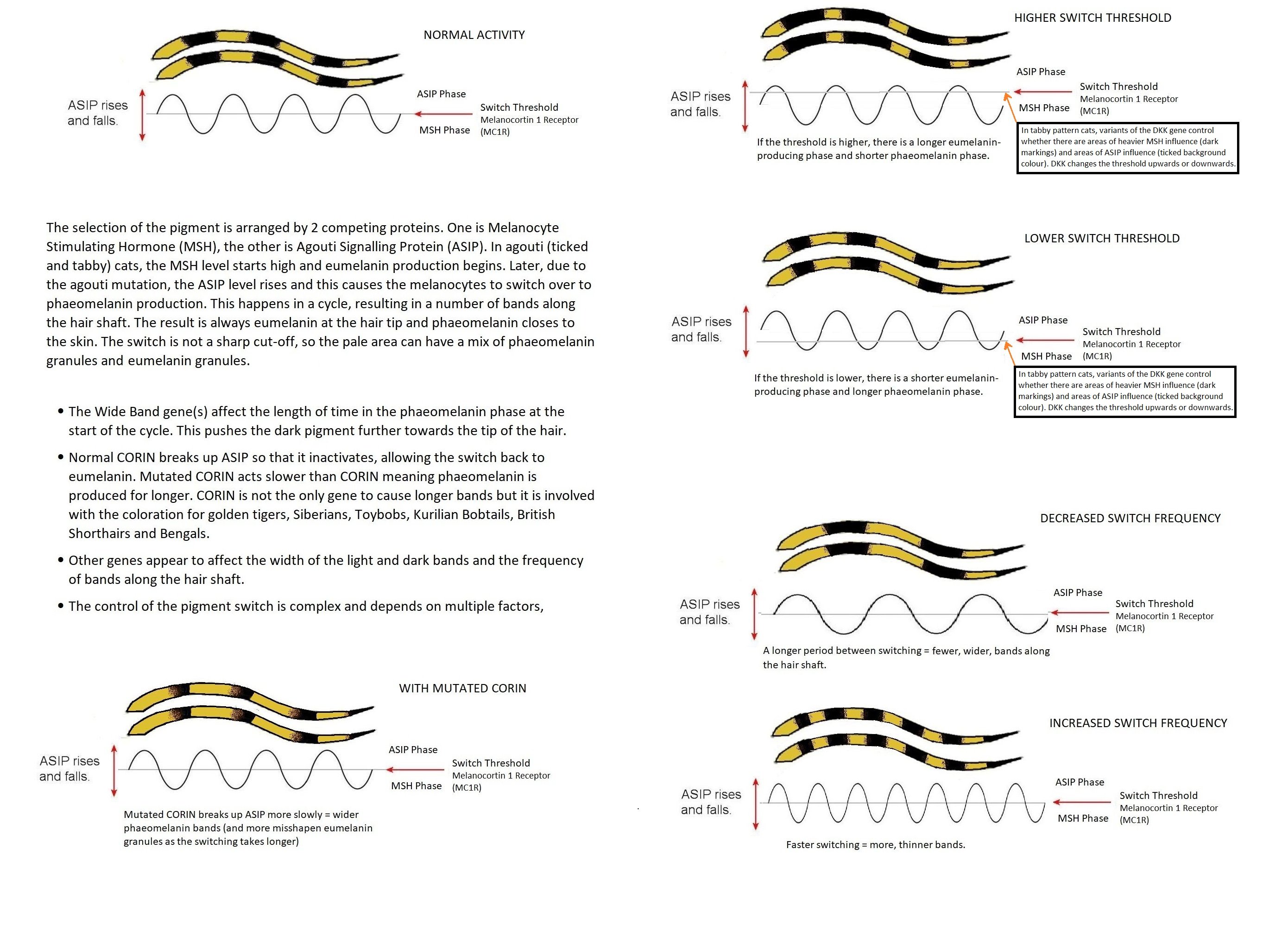
GENETICS OF AGOUTI AND CORIN GENES
The selection of the pigment is arranged by 2 competing proteins. One is Melanocyte Stimulating Hormone (MSH), the other is Agouti Signalling Protein (ASIP). In agouti (ticked and tabby) cats, the MSH level starts high and eumelanin production begins. Later, due to the agouti mutation, the ASIP level rises and this causes the melanocytes to switch over to phaeomelanin production. This happens in a cycle, resulting in a number of bands along the hair shaft. The result is always eumelanin at the hair tip and phaeomelanin closes to the skin. The switch is not a sharp cut-off, so the pale area can have a mix of phaeomelanin granules and eumelanin granules.
MSH is secreted by the pituitary gland. ASIP is secreted in the hair follicle.
The Agouti locus encodes the agouti signalling protein (ASIP). Animals that inherit 2 copies of the non-agouti allele (solid colour) cannot build a normally functioning ASIP and their pigment cells remain stuck in the eumelanin phase.
The Extension locus encodes the melanocortin-1 receptor (MC1R). The Melanocortin 1 Receptor (MC1R) receptor is the key switch between eumelanin or phaeomelanin production. MC1R can be activated from the outside of the cell. If MSH comes along and binds to MC1R the pigment cell is signalled to activate eumelanin production. ASIP competes with MSH; it also wants to bind to the MC1R and this blocks the receptor. If MSH can’t bind to MC1R it can’t signal the cell to produce eumelanin, so the melanocytes produce phaeomelanin.
Tyrosinase Related Protein 1 (TYRP1) is an enzyme that influences the quantity and quality of melanins. Both pigments derive from the amino acid tyrosine. The control of the pigment switch between eumelanin and phaeomelanin is regulated by multiple factors including the pH of the cellular environment and the levels of tyrosinase. The ratio of the 2 pigments depends on the catalytic activity of tyrosinase, and the availability of low molecular weight thiol compounds such as cysteine or glutathione.
CORIN plays an important part in the length of the phaeomelanin band. Normal CORIN breaks up ASIP so that it inactivates allowing the switch back to eumelanin. Normal CORIN acts faster than mutated CORIN. The longer it takes for CORIN to break up ASIP (thereby lowering the level of ASIP) the longer it produces phaeomelanin so the longer the yellow band. CORIN is not the only gene to cause longer bands but it is involved with the coloration for golden tigers, Siberians, Toybobs, Kurilian Bobtails, British Shorthairs and Bengals.


The known Corin mutations are:

|
|
|
ROLE OF CORIN GENE IN PLACENTA DEVELOPMENT
A gene codes for a protein, and because proteins are used in several physiological processes, a gene that is expressed as pigment in the skin/fur has functions elsewhere in the body e.g. melanin is involved in the inner ear, hence the link between blue-eyed solid white (and blue eyed high facial white) and deafness.
wbSIB (sunshine) is a missense mutation (spelling error), presumed to cause altered/reduced function
wbBRI (copper) is a nonsense mutation (stops translation), presumably causing total loss-of-function
Further molecular studies are needed to find the effects of these mutations on agouti signalling as well as on the water/sodium homeostasis mechanism.
There is a small concern surrounding copper (wbBRI) because CORIN is also expressed in the trophoblast (the part of the very early embryo that becomes the placenta). Total loss of function may result in poor development of the placenta. This could lead to miscarriage, stillbirth, poor foetal growth leading to under-sized kittens that may not survive, however, no problems directly attributable to the Corin gene have been reported by breeders. To this can be added the amount of inbreeding to fix the copper trait, resulting in inbreeding depression. There are some influential males that are over-represented in the gene pool, but far enough back that they are not obvious on 3- or 5-generation pedigrees. There is no information specific to CORIN and pregnancy in cats, but (as with all mutations) it is wise to be aware of the gene's other roles.
Bengals have a “wild type” CORIN mutation inherited from the Asian Leopard Cat (ALC). Wild type mutations might not have the same prenatal/metabolic effect eithers because they have been subjected to natural selection that weeds out mutations with harmful side effects or because the ALC may have other genes that compensate for loss of CORIN function. Their environment makes it necessary to conserve water and sodium and this would select against CORIN loss of function mutations. (Could the Asian Leopard agouti variants counteract CORIN variants?)